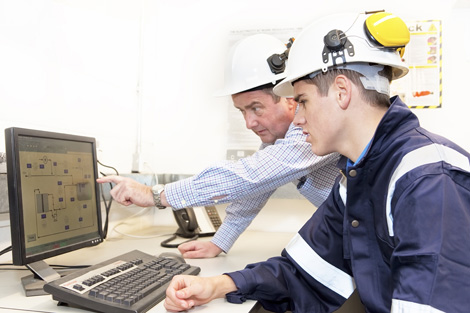 At
the February Sci-Bar meeting, Alex Brown, a chemist from the National
Nuclear Laboratory in Warrington delivered an enthusiastic presentation
on in silico approaches [the current description of computer based data analysis] to managing the challenges of cleaning up
Britain's first nuclear plant at Sellafield. Using a set of images and a
time-lapse video, Alex took us through the acronym-filled world of the
former Windscale site, which grew out of the earlier Royal Ordnace
works, to take advantage of the early stage developments that
underpinned the nuclear weapons industry. The various components of the
plant that have been built since the World War II, comprise reactor
towers, fuel waste ponds and a range of waste storage areas. These are all there to deal
with the the original purpose of power generation via the Magnox
system, and the safe storage and disposal of on site waste. As Alex reminded us, Sellafield also handles waste brought in by rail from other plants around the country. It is likely that
complete decommissioning of Sellafield will take up to 100 years from
today.
At
the February Sci-Bar meeting, Alex Brown, a chemist from the National
Nuclear Laboratory in Warrington delivered an enthusiastic presentation
on in silico approaches [the current description of computer based data analysis] to managing the challenges of cleaning up
Britain's first nuclear plant at Sellafield. Using a set of images and a
time-lapse video, Alex took us through the acronym-filled world of the
former Windscale site, which grew out of the earlier Royal Ordnace
works, to take advantage of the early stage developments that
underpinned the nuclear weapons industry. The various components of the
plant that have been built since the World War II, comprise reactor
towers, fuel waste ponds and a range of waste storage areas. These are all there to deal
with the the original purpose of power generation via the Magnox
system, and the safe storage and disposal of on site waste. As Alex reminded us, Sellafield also handles waste brought in by rail from other plants around the country. It is likely that
complete decommissioning of Sellafield will take up to 100 years from
today. By adding magnetite into a set of simulation experiments, a closer fit to the observed solubility characteristics in the tank was obtained. As the pH drops from its starting alkaline value as dissolved, atmospheric CO2 acidifies the liquor in the sludge tank, there is a concomitant impact on the equilibrium position of the liquid versus solid phase of Brucite in the waste mixture. It seems to me that since this is an accepted outcome of the plant configuration (ie aeration cannot be conveniently contained), the model requires incorporation of the multiple pH dependent events that will collectively determine the distribution of ionised Brucite in its dissolved and precipitated phases in the mixture. It was good to hear that Alex and his colleagues are now developing more sophisticated models in order to address such issues.
As is the norm at the Widnes SciBar, the audience contained a sprinkling of seasoned veterans of the nuclear industry, who shared some of their fundamental knowledge and experience, which added colour to the talk. Alex also fielded several questions about the value of modelling, the time and computing power needed, and Bob invited Alex to comment on the future challenges and opportunities for Nuclear Power. There were also some detailed questions about gaseous waste issues, the replacement of Magnesium casing with Zirconium and several more general questions about site access and visitors. Bob, it might be an opportunity for a SciBar coach trip! In the absence of an immediate trip, "Britain’s Nuclear Secrets – Inside Sellafield" with Jim Al-Khalili which was on the BBC last year., isn't currently available via the BBC, but it is here:- www.dailymotion.com/video/
Thanks again to Alex and all those who attended: another full house at the Hillcrest Hotel. The next talk will be announced by Bob, and looks at the future of technology through the eyes of Star Trek's creator, Gene Rodenberry! And I leave below a link for those wishing to swell the ranks of the British Science Association. Personally, why wouldn't you!